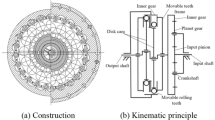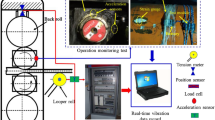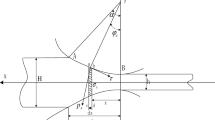Abstract
The contact pairs of oscillatory roller transmission are all high pairs, so the relative sliding occurs due to the different tangential velocity of the contact points. This paper derived the mathematical model and kinematic model of oscillatory roller transmission and proposed a new sliding ratio modeling method for oscillatory roller transmission based on the velocity decomposition. The impacts of geometry design parameters on sliding ratios for oscillatory roller transmission were studied. Results suggest that sliding ratios first decrease and then increase as the rotation angle of movable rolling teeth grows. However, for parametric studies, sliding ratios increase as the radius of disk cam and transmission ratio rise, and decrease as the radius of movable rolling teeth increases. The variation of the eccentricity of disk cam has a great influence on the fluctuating values of sliding ratios. The growth of the radius of movable rolling teeth and the eccentricity of disk cam significantly increase the peak-to-peak values of sliding ratios. Relatively, the radius of disk cam and transmission ratio have small impact on sliding ratios. The results provide theoretical guidance for reducing friction and improving the mechanical efficiency of oscillatory roller transmission in engineering.
Similar content being viewed by others
References
S. M. Liang, B. Fu and D. M. Wang, Tooth profile synthesis and strength computation of swing movable teeth drives, Key Engineering Materials, 474–476 (2011) 162–167.
L. Z. Xu and W. T. Song, Elastic hydrodynamic lubrication analysis for a sine movable tooth drive, Advances in Mechanical Engineering, 10(12) (2018) 1–11.
L. Z. Xu and W. P. Wang, Natural frequency and modes for a sine movable tooth drive, Iran J. Sci. Technol. Trans. Mech. Eng., 43 (2019) 267–273.
K. Kato and M. Wada, Kinematic analysis and simulation of active-caster robotic drive with ball transmission, Advanced Robotics, 31(7) (2016) 355–367.
L. Y. Duan, Z. J. An and R. G. Yang, Mechanical model of coupling rolling and sliding friction in real-time non-clearance precision ball transmission, Tribology International, 103 (2016) 218–227.
H. Terada, The development of gearless reducers with rolling balls, J. of Mechanical Science and Technology, 24(1) (2010) 189–195.
L. Z. Xu and Y. L. Liang, Torque for an electromagnetic harmonic movable tooth drive system, Mech. Mach. Theory, 98 (2016) 190–198.
J. L. Zhao, S. Z. Yan and J. N. Wu, Analysis of parameter sensitivity of space manipulator with harmonic drive based on the revised response surface method, Acta Astronautica, 98 (2014) 86–96.
W. K. Nam, J. W. Shin and S. H. Oh, Design of thin plate-type speed reducers using balls for robots, J. of Mechanical Science and Technology, 27 (2013) 519–524.
C. Gorla, P. Davoli and F. Rosa, Theoretical and experimental analysis of a cycloidal speed reducer, J. Mech. Des., 130(11) (2008) 1671–1676.
M. Blagojevic, N. Marjanovic and Z. Djordjevic, A new design of a two-stage cycloidal speed reducer, J. Mech. Des., 133(8) (2011) 85001–85001.
W. S. Wang and Z. H. Fong, Undercutting and contact characteristics of longitudinal cycloidal spur gears generated by the dual face-hobbing method, Mech. Mach. Theory, 46(4) (2011) 399–411.
W. S. Lin, Y. P. Shih and J. J. Lee, Design of a two-stage cycloidal gear reducer with tooth modifications, Mech. Mach. Theory, 79 (2014) 184–197.
C. Oezel and Y. Ortac, A study on the cutting errors of the tooth profiles of the cycloidal gears manufactured in CNC milling machine, Int. J. Materials and Product Technology, 53(1) (2016) 42–60.
Z. Y. Ren, S. M. Mao and W. C. Guo, Tooth modification and dynamic performance of the cycloidal drive, Mechanical Systems and Signal Processing, 85 (2017) 857–866.
J. Wu, H. Liu, P. Wei, Q. Lin and S. Zhou, Effect of shot peening coverage on residual stress and surface roughness of 18CrNiMo7-6 steel, International J. of Mechanical Sciences (2020) 105785.
R. H. Sun, C. S. Song and C. C. Zhu, Tooth surface modelling and mesh behaviors for paralleled beveloid gears, J. Mech. Des., 142(5) (2019) 1–25.
Acknowledgments
The authors would like to thank the National Key R&D Program of China (2019YFB2004700), Key Research and Development Project of Chongqing Science and Technology Program (cstc2018jszx-cyztzxX0038).
Author information
Authors and Affiliations
Corresponding author
Additional information
Song Chaosheng is a Professor at State Key Laboratory of Mechanical Transmissions, Chongqing University, China. His research interests include gear geometry design and dynamics of geared rotor system.
Wei Changxu is currently pursuing the M.S. at the State Key Laboratory of Mechanical Transmissions, Chongqing University, China. His research area is the precision gear transmission and tooth contact analysis.
Rights and permissions
About this article
Cite this article
Song, C., Wei, C., Zhu, C. et al. Theoretical investigation of sliding ratio on oscillatory roller transmission. J Mech Sci Technol 35, 3081–3088 (2021). https://doi.org/10.1007/s12206-021-0630-0
Received:
Revised:
Accepted:
Published:
Issue Date:
DOI: https://doi.org/10.1007/s12206-021-0630-0




